A meteorite study shows that in ancient lunar history, the Moon’s crust contained more water than scientists previously thought. Moonquakes are similar to earthquakes. In the case of the Moon, they are caused by folds that form on the Moon’s surface as it shrinks. The Moon is shrinking because the Moon’s interior has cooled over the past few hundred million years.
Moon water
Indian scientists, in cooperation with an international team of researchers, have identified evidence of an increased likelihood of the presence of water ice in the polar craters of the Moon, reports the website of the Indian Space Research Organization. The study suggests that the amount of subsurface ice in the first few meters is about 5 to 8 times greater than at the surface in both the north and south polar regions of the Moon. The discovery of these significant deposits of underground ice could significantly change the course of future lunar exploration.
Drilling on the Moon to sample or excavate this ice will be critical to supporting future missions and ensuring a long-term human presence on the lunar surface. Moreover, the study also shows that the area of water ice in the north polar region is 2 times greater than in the south polar region, providing valuable information for mission planning and site selection.
The study, carried out by the Indian Institutes of Technology Kanpur and Dhanbad in collaboration with scientists at the University of Southern California and NASA’s Jet Propulsion Laboratory, supports the hypothesis that the main source of subsurface water ice at the lunar poles is the release of gases during Imbrian volcanism, 3.8–3. 2 billion years ago.
As the agency notes, in their study, scientists used data obtained by equipment on board NASA’s Lunar Reconnaissance Orbiter (LRO), launched in 2009, and the Indian interplanetary station Chandrayaan-2, which entered lunar orbit in 2019.
Lunar meteorite reveals the Moon once had much more water than expected
It’s long been thought that the lunar surface has been dry for thousands or even millions of years, but there may be more water on the lunar surface than we thought, and we just need to find a way to get it. A new study has found that about 4 billion years ago, the surface of the Moon was rich in water, reports the journal Nature Astronomy.
This research could be an important step toward better understanding the evolution of the Moon, and could also help inform future lunar missions, including NASA’s Artemis 3 mission, which aims to return humans to the lunar surface by 2026 at the earliest and use what it finds. there is frozen water for a sustainable presence on the Moon.

On the left is an image of the Moon, on the right is a sample of a lunar meteorite. NASA/Tara Hayden
University of Western Ontario postdoctoral fellow Tara Hayden examined a lunar meteorite that was once part of the moon’s surface and contains the mineral apatite. This common phosphate made it possible for the first time to directly study an unknown stage of lunar evolution when the Moon was molten.
A meteorite study shows that in ancient lunar history, the Moon’s crust contained more water than scientists previously thought. “Discovering apatite in the early lunar crust for the first time is incredibly exciting as we can finally begin to piece together this unknown phase of lunar history,” Hayden said in a statement. “We found that the Moon’s early crust was richer in water than we expected, and its volatile stable isotopes reveal an even more complex history than we previously knew.”
Hayden explained that studying lunar meteorites, such as the one she studied in search of apatite, is important for learning more about the Moon and could possibly reveal information that was missing from samples brought back to Earth in the 1960s and 1970s. 1960s as part of the Apollo program.
When the Apollo lunar samples were first examined, scientists found them to be “poor in volatiles.” Volatiles are chemicals that evaporate easily at relatively low temperatures; The water is moderately volatile, evaporating at a temperature of 212 degrees Fahrenheit (100 degrees Celsius). This has led to the suggestion that the Moon is “dry to the bone.”
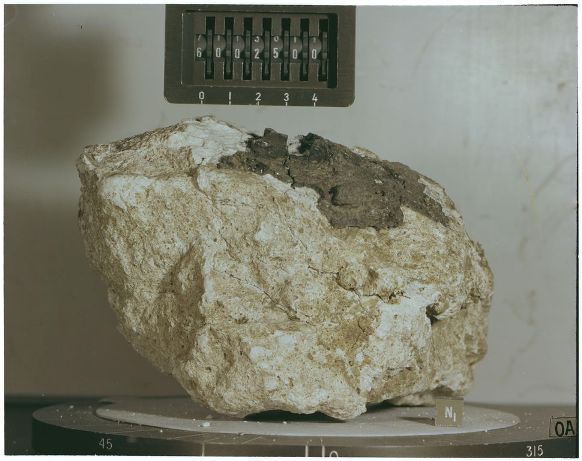
A rock collected from the surface of the Moon during the Apollo 16 mission. NASA
This assumption was challenged in 2008 when scientists discovered significant amounts of water and volatiles in new Apollo samples, prompting them to take a second look. As this research has continued over the past 15 years, other samples, such as lunar meteorites that fell to Earth after being freed from the lunar surface by asteroid impacts and other impacts, have shown that the Moon throughout its history was not completely dry.
“Unraveling the history of water in the earliest lunar crust, formed approximately 4.5 billion years ago, is important for improving our understanding of the origins of water in the solar system,” said Open University professor of planetary science and exploration Mahesh Anand. “Ancient rock samples from the Moon in the form of lunar meteorites provide an excellent opportunity to conduct such research.”
Frozen water on the lunar surface could be used on future missions not only to keep astronauts alive, but also to extract hydrogen as fuel that could be used to return crews back to Earth or to travel deeper into the solar system, such as to Mars.
Lunar earthquakes and lunar landslides
When planning crew landing sites on the Moon, from the upcoming Artemis missions to future durable lunar settlements, mission planners must consider a host of lunar parameters. For example, the shape of the terrain can make or break a mission, and the potential for large volumes of submerged water can make one location much more attractive than its drier counterpart. But geologists now suggest it’s also important to be mindful of lunar earthquakes and lunar landslides, they write in The Planetary Science Journal.
As scientists emphasize, this is no longer an academic question. Researchers in the moon’s south polar region, located near the planned landing side of Artemis 3, due to land in 2026, have identified fault lines that triggered a major lunar earthquake about 50 years ago.
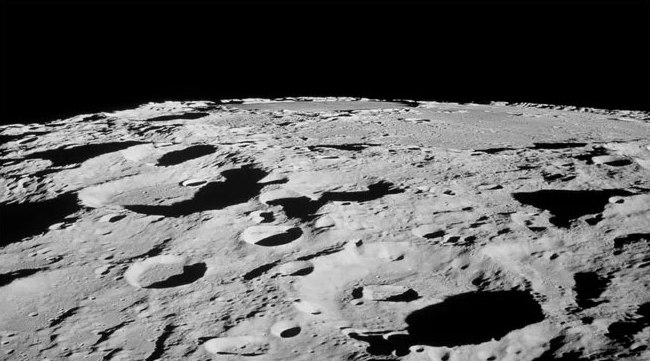
Photograph of the Moon’s surface. NASA
Some Apollo missions carried seismometers with them. On March 13, 1973, a particularly strong lunar earthquake shook seismometers in the general direction of the Moon’s south pole. Decades later, a lunar reconnaissance orbiter flew over the south pole and discovered a network of fault lines. Using new models, researchers linked these faults to the lunar earthquake.
The study adds to our picture of what lunar earthquakes are like in general. In principle, moonquakes are similar to earthquakes. In the case of the Moon, they are caused by folds that form on the Moon’s surface as it shrinks. The Moon is shrinking because the Moon’s interior has cooled over the past few hundred million years. According to scientists, this is similar to the wrinkling of a raisin, which also helps us visualize the formation of these folds.
Additionally, the Moon’s surface is much less densely packed than the Earth’s and is often made up of loose particles that can be ejected and scattered by impacts. As a result, lunarquakes are more likely to cause landslides.
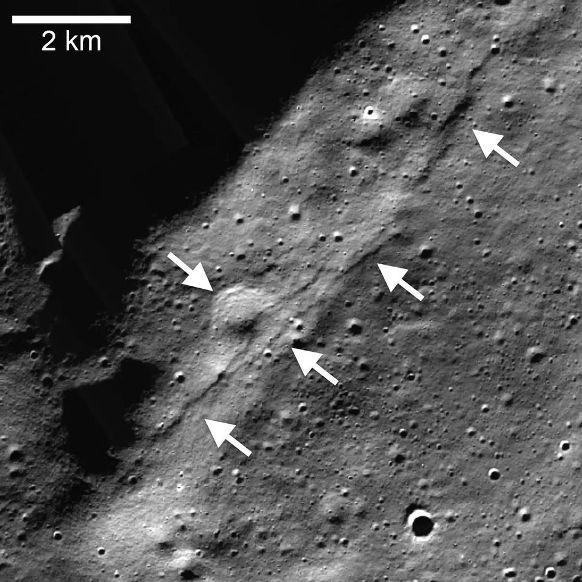
Lunar Reconnaissance Orbiter camera, Narrow Angle Camera (NAC) mosaic of the Wiechert Lobate Cluster Cluster (arrows pointing left) near the Moon’s south pole. The thrust fault scarp cut a collapsed crater approximately 1 kilometer (0.6 mi) in diameter (arrow pointing to the right). NASA/LRO/LROC/ASU/ Smithsonian Institution
As the day approaches when human boots walk on the moon again, the people in question will have to consider the possibility that the ground beneath those boots may not be as stable as they might have hoped, according to researchers. The researchers’ model suggests, for example, that the walls of Shackleton Crater, known for its ice, are vulnerable to landslides.
The latest study shows that the Moon is still geologically active and provides evidence that tectonic faults, created as the Moon’s interior gradually cools and contracts, are found near some of the areas identified by NASA as candidate regions for the landing of Artemis III, the first planned mission. Artemis.”
The moon holds clues to the evolution of Earth, the planets and the sun, and new NASA-funded research is helping scientists better understand some of the mysteries beneath the surface of our closest cosmic neighbor. This study was co-authored by NASA Marshall Space Flight Center Chief Scientist Renee Weber, who is also a member of NASA’s Artemis Science Team, a broad group of scientists from across the agency working to usher in a new era of deep space science.
As a lunar seismologist and lunar geophysicist, Weber provides expert assistance to the Artemis science team, including knowledge of the types of seismic events that can occur on the Moon to better understand its internal geology and surface environment.
“This study examined tectonic faults and steep slopes in the south polar region of the Moon and found that some areas are susceptible to seismic shaking and regolith landslides,” Weber said. “Once the faults were mapped, we calculated the size of potential lunar earthquakes that might occur to create a seismic hazard map in the vicinity of tectonic faults and steep slopes.”
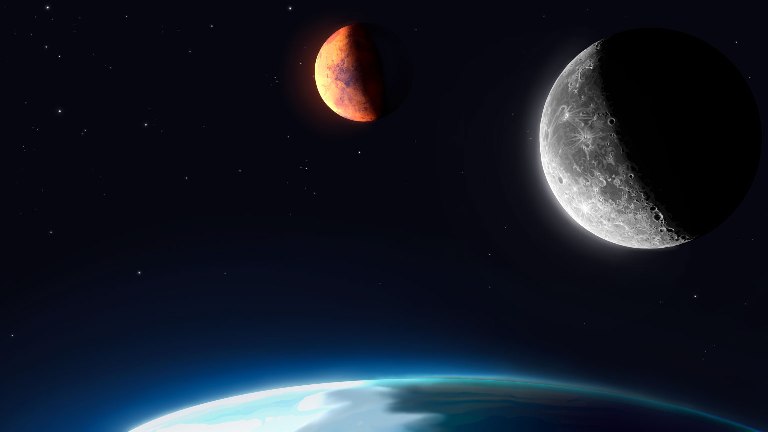
The study found that relatively small, young thrust faults, called lobate scarps, are widespread in the lunar crust. Scarps form where compressive forces break the crust and push or push rock on one side of a fault up and through the rock on the other side. The contraction is caused by the cooling of the still hot interior of the Moon and tidal forces of the Earth, which leads to global compression. The ledges were identified in images taken by the Lunar Reconnaissance Orbiter camera aboard NASA’s LRO (Lunar Reconnaissance Orbiter).
The formation of faults is accompanied by seismic activity in the form of shallow lunar earthquakes. Such small lunar earthquakes were recorded by the Apollo Passive Seismic Network, a series of seismometers deployed by Apollo astronauts, and could potentially also be recorded by a new seismic instrument scheduled to launch next year aboard the upcoming CLPS (Commercial Lunar Payload Service) flight. The tool, the Farside Seismic Suite, will return the agency’s first seismic data from the far side of the Moon, helping scientists understand the region’s tectonic activity. The data could also show how often the far side of the Moon is impacted by small meteorites, and determine whether seismicity on the far side of the Moon is different from what was measured during Apollo on the near side of the Moon.
“To better understand the seismic hazard posed by future human activity on the Moon, we need new seismic data not only at the South Pole, but around the world,” Weber said. “Missions like the upcoming Farside Seismic Suite, as well as future potential missions like the Lunar Geophysical Network concept, will expand on the measurements taken during Apollo and add to our knowledge of global seismicity.”
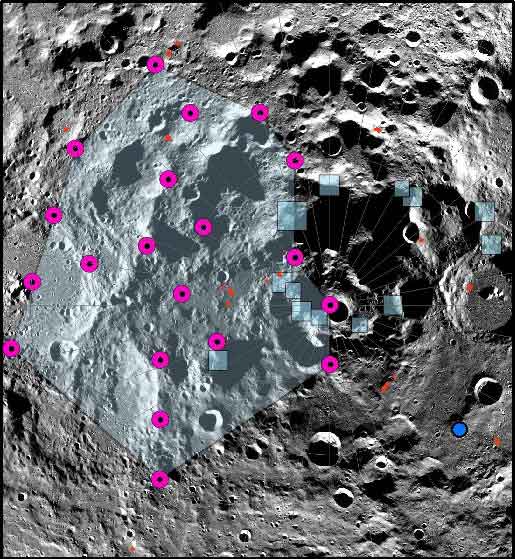
The epicenter of one of the strongest lunar earthquakes recorded during the Apollo passive seismic experiment was located in the south polar region of the Moon. However, the exact location of the epicenter could not be determined. A cloud of possible locations (magenta dots and cyan polygon) of a large, shallow lunar earthquake, using a relocation algorithm specifically tailored for very sparse seismic networks, is distributed near the pole. The blue rectangles show the supposed landing sites of Artemis III. Lobate thrust scarps are shown as small red lines. The epicenter cloud covers a number of lobate scarps and many of the Artemis III landing areas. NASA/LROC/ASU/Smithsonian Institution
As NASA develops long-term infrastructure on the lunar surface, Weber’s research will provide invaluable information for the Artemis science team, which will refine a mission architecture that maintains flexibility for science and operations at various landing sites, and will apply new scientific knowledge such as as it continues research on seismic measurements collected along the way.
According to Weber, the study does not influence the process of selecting the Artemis III landing region because it is difficult to accurately estimate how often moonquakes occur in a particular region, and, as with earthquakes, scientists cannot predict moonquakes. Additionally, for a shorter mission such as Artemis III, the likelihood of hazards due to seismic shaking is much lower.
As NASA develops the long-term infrastructure, the agency will identify potential regions where various elements could be installed closer to the dates of future Artemis missions. In this site selection process, some of the factors to consider may be geographic characteristics such as proximity to tectonic features and topography, which makes Weber’s study even more valuable.
NASA will measure lunar earthquakes using the InSight Mars mission, which was used to explore Mars
The technology behind the two seismometers that make up NASA’s Farside Seismic Facility has been used to detect more than a thousand earthquakes on the Red Planet. One of two seismometers customized for the lunar surface, based on instruments originally developed for NASA’s InSight Mars mission, recorded more than 1,300 marsquakes before the mission ended in 2022.
The two seismometers, part of a payload called the Farside Seismic Suite (FSS), will arrive in 2026 at the Schrödinger Basin, a wide impact crater located about 300 miles (500 kilometers) from Earth—the moon’s south pole. The self-contained solar-powered complex has its own computer and communications equipment, and the ability to protect itself from the intense heat of the lunar day and cold night conditions.

The Seismic Experiment on Internal Structure (SEIS) instrument aboard NASA’s Mars InSight probe sits inside a copper-colored hexagonal casing in this photo taken by the lander’s robotic arm camera on December 4, 2018. SEIS technology is used on Farside Seismic. Suite to the Moon. NASA/JPL-Caltech
The facility, which is 30 times more sensitive than its Apollo predecessors, will detect the moon’s seismic “background” vibration caused by pebble-sized micrometeorites that fall to the surface. This will help NASA better understand the current impact environment as the agency prepares to send Artemis astronauts to explore the lunar surface.
Planetary scientists want to know what the FSS will tell them about the Moon’s internal activity and structure. What they learn will provide insight into how the Moon formed and evolved, as well as rocky planets such as Mars and Earth.
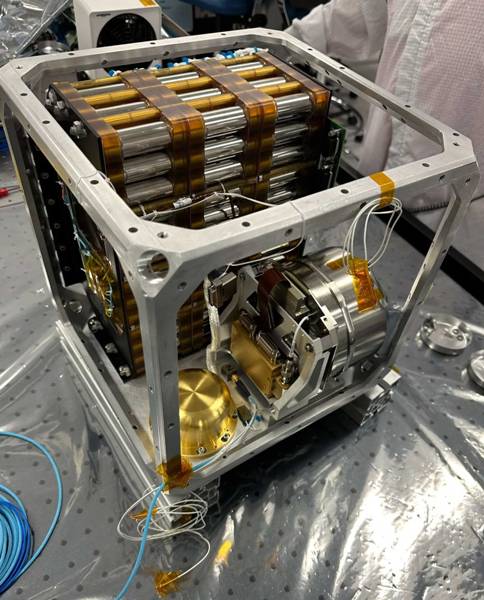
Pictured during assembly in November 2023, the Farside Seismic Suite’s inner cube houses a large NASA payload array (at the rear) and two seismometers. The gold puck-shaped device houses a short-period sensor, and the silver body houses an ultra-wideband seismometer. NASA/JPL-Caltech
The Very Broadband Seismometer, or VBB, is the most sensitive seismometer ever created for use in space exploration: it can detect earth movements smaller than one hydrogen atom. A thick cylinder about 5 inches (14 centimeters) in diameter, it measures up and down motion using a pendulum held by a spring. It was originally created by the French space agency CNES (Centre National d’Etudes Spatiales) as an emergency replacement (“backup backup”) instrument for InSight.
The complex’s smaller seismometer, called the short period sensor, or SP, was built by Kinemetrics in Pasadena, California, in collaboration with the University of Oxford and Imperial College London. The puck-shaped device measures motion in three directions using sensors etched onto three square silicon chips, each about 1 inch (25 millimeters) wide.
The FSS payload was assembled at JPL last year. In recent weeks, it has endured rigorous environmental testing in vacuums and extreme temperatures simulating space, as well as violent shaking simulating the motion of a rocket during launch.
Charged Moon Dust
Researchers are studying data from recent suborbital flight tests to better understand lunar regolith, lunar dust, and its potentially destructive consequences. The experiment, developed jointly by NASA and the University of Central Florida, sheds light on how these abrasive dust particles interact with astronauts, their spacesuits and other equipment on the Moon.
The Electrostatic Regolith Interaction Experiment (ERIE) was one of 14 NASA-supported payloads launched Dec. 19 aboard Blue Origin’s unmanned New Shepard rocket from Launch Pad One in West Texas. During flight testing, ERIE collected data to help researchers at Kennedy Space Center in Florida study tribocharging, or friction-induced charges, in microgravity.
The Moon is highly charged by phenomena such as solar wind and ultraviolet light from the Sun. Under such conditions, regolith grains are attracted to lunar explorers and their equipment. Enough regolith can cause instruments to overheat or not function properly.
One of the main problems is that it is impossible to electrically ground anything on the Moon. Thus, even a lander, rover, or indeed any object on the Moon will have polarity. There is currently no good solution to the dust charge problem. “Dust has sharp edges that can scratch surfaces and block thermal radiators,” said Jay Phillips, director of NASA Kennedy’s Spacecraft Electrostatics and Charging Division.
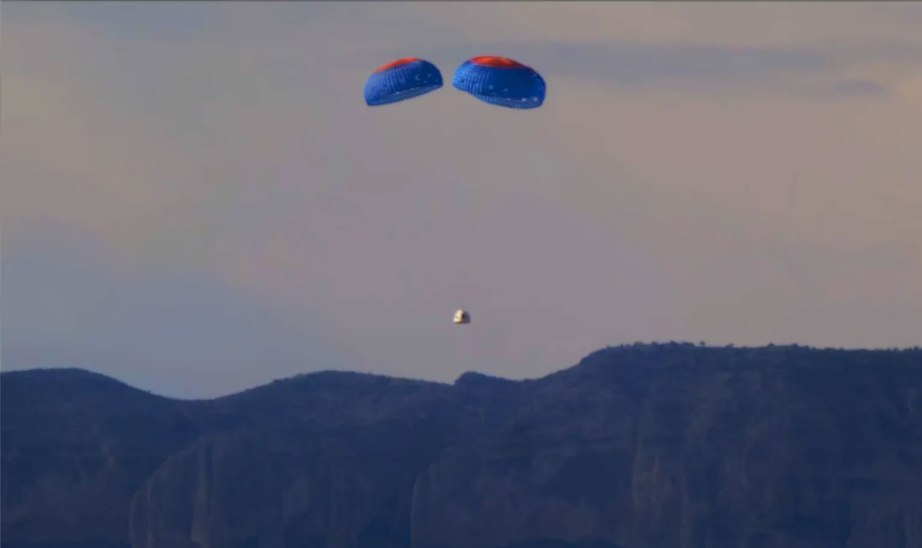
The New Shepard crew capsule parachutes down during launch on Tuesday, December 19, 2023. Blue Origin
The ERIE payload spent about three minutes in microgravity during the New Shepard capsule’s suborbital flight, which lasted about 10 minutes, before landing safely back on Earth in the Texas desert. A camera recorded the interaction and Phillips and his team are reviewing the data.
The results will serve as the basis for future missions destined for the lunar surface. For example, using triboelectric sensors on the rover’s wheels, astronauts can measure the positive and negative charges between the vehicle and the regolith on the lunar surface. The ultimate goal is to develop technologies that will help prevent astronauts’ suits and electronics from sticking and becoming damaged during missions.




